
The John Newbery Medal, frequently shortened to the Newbery, is a literary award given by the Association for Library Service to Children (ALSC), a division of the American Library Association (ALA), to the author of "the most distinguished contributions to American literature for children". The Newbery and the Caldecott Medal are considered the two most prestigious awards for children's literature in the United States. Books selected are widely carried by bookstores and libraries, the authors are interviewed on television, and master's theses and doctoral dissertations are written on them. Named for John Newbery, an 18th-century English publisher of juvenile books, the winner of the Newbery is selected at the ALA's Midwinter Conference by a fifteen-person committee. The Newbery was proposed by Frederic G. Melcher in 1921, making it the first children's book award in the world. The physical bronze medal was designed by Rene Paul Chambellan and is given to the winning author at the next ALA annual conference. Since its founding there have been several changes to the composition of the selection committee, while the physical medal remains the same.
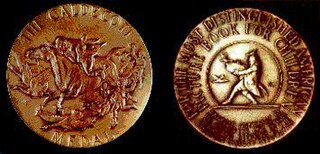
The Randolph Caldecott Medal, frequently shortened to just the Caldecott, annually recognizes the preceding year's "most distinguished American picture book for children". It is awarded to the illustrator by the Association for Library Service to Children (ALSC), a division of the American Library Association (ALA). The Caldecott and Newbery Medals are considered the most prestigious American children's book awards. Beside the Caldecott Medal, the committee awards a variable number of citations to runners-up they deem worthy, called the Caldecott Honor or Caldecott Honor Books.

Ed Tse-chun Young is a Chinese-born American illustrator and writer of children's picture books. He won one Caldecott Medal for the year's best American picture book and for his lifetime contribution as a children's illustrator he was twice the U.S. nominee for the Hans Christian Andersen Award.

David Wiesner is an American illustrator and writer of children's books, known best for picture books including some that tell stories without words. As an illustrator he has won three Caldecott Medals recognizing the year's "most distinguished American picture book for children" and he was one of five finalists in 2008 for the biennial, international Hans Christian Andersen Award, the highest recognition available for creators of children's books.
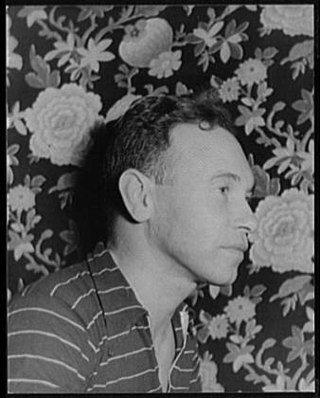
Thomas Scofield Handforth was an American artist and etcher. He wrote and illustrated the children's picture book Mei Li based on personal experience in China and won the 1939 Caldecott Medal for illustration.

The Horn Book Magazine, founded in Boston in 1924, is the oldest bimonthly magazine dedicated to reviewing children's literature. It began as a "suggestive purchase list" prepared by Bertha Mahony Miller and Elinor Whitney Field, proprietors of the country's first bookstore for children, The Bookshop for Boys and Girls. Opened in 1916 in Boston as a project of the Women's Educational and Industrial Union, the bookshop closed in 1936, but The Horn Book Magazine continues in its mission to "blow the horn for fine books for boys and girls" as Mahony wrote in her first editorial.
Blair Lent, who sometimes wrote as Ernest Small, was an American illustrator and writer of children's books, perhaps best known for those with Chinese themes such as Tikki Tikki Tembo (1968). He won the 1973 Caldecott Medal for U.S. picture book illustration, recognizing The Funny Little Woman by Arlene Mosel. Lent used a wide range of techniques in his illustrations, including acrylic painting, cardboard cutouts, colored pencil and ink and wash.
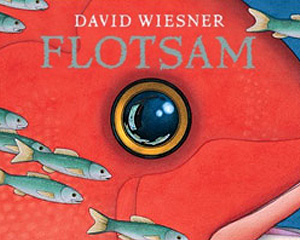
Flotsam is a children's wordless picture book written and illustrated by David Wiesner. Published by Clarion/Houghton Mifflin in 2006, it was the 2007 winner of the Caldecott Medal; the third win for David Wiesner. The book contains illustrations of underwater life with no text to accompany them.

The Girl Who Loved Wild Horses, written and illustrated by Paul Goble, is a children's picture book originally released by Bradbury Press in 1978. It was the recipient of the Caldecott Medal for illustration in 1979. As of 1993, the book has been published by Simon & Schuster.

Arlene Tichy Mosel was an American children's librarian who wrote the text for two award-winning children's picture books illustrated by Blair Lent, both retelling traditional material. Tikki Tikki Tembo won the annual Boston Globe–Horn Book Award and Lent won the annual Caldecott Medal for The Funny Little Woman.

The Lion & the Mouse is a 2009 nearly wordless picture book illustrated by Jerry Pinkney. The book, published by Little, Brown and Company, tells Aesop's fable of The Lion and the Mouse. In the story, a mouse's life is a spared by a lion. Later, after the lion is trapped, the mouse is able to set the lion free. Adapting the fable, with the moral that the weak can help the strong, as a wordless picture book was seen as a successful way of overcoming the brief plot generally found in the source stories. While it was Pinkney's first wordless picture book, it was not the first time he had told the story, having previously included it in his Aesop's Fables, published in 2000. Pinkney, who had received five Caldecott Honors, became the first African American to win the Caldecott Medal for his illustrations in the book. His illustrations were generally praised for their realism and sense of place. The cover illustrations, featuring the title characters but no text, drew particular praise.

In the children's picture book Chanticleer and the Fox, Barbara Cooney adapted and illustrated the story of Chanticleer and the Fox as told in The Nun's Priest's Tale in Chaucer's Canterbury Tales, translated by Robert Mayer Lumiansky. Published by Crowell in 1958, it was the recipient of the Caldecott Medal for illustration in 1959. It was also one of the Horn Book "best books of the year".

Jon Klassen is a Canadian writer and illustrator of children's books and an animator. He won both the American Caldecott Medal and the British Kate Greenaway Medal for children's book illustration, recognizing the 2012 picture book This Is Not My Hat, which he also wrote. He is the first person to win both awards for the same work.

A Ball for Daisy is a 2011 children's wordless picture book written and illustrated by Chris Raschka. The book tells the story of a dog named Daisy, who has a beloved ball destroyed and then replaced. Raschka won the 2012 Caldecott Medal for his illustrations in the book. The creation of the book took years but was praised for its ability to evoke emotion in the reader. A sequel, Daisy Gets Lost, was released in 2013.

This Is Not My Hat is a 2012 American children's picture book by the author and illustrator Jon Klassen. The story is told through the unreliable narration of a little fish, who has stolen a hat from a big fish and how the big fish reacts to the theft. It is a thematic follow-up to I Want My Hat Back (2011) and was meant to be a more literal sequel until Klassen took a suggestion to change which animals were in the story. The book was well received by critics who praised its dark or ironic humor which could only be understood by comparing the words of the little fish's narration against the events of the illustrations. In addition to several positive reviews, Klassen won the 2013 Caldecott Medal and the 2014 Kate Greenaway Medal becoming the first book to win both awards. This is Not My Hat was also a commercial success.
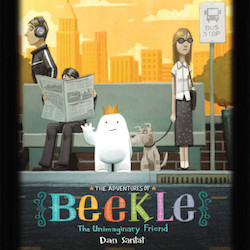
The Adventures of Beekle: The Unimaginary Friend is a 2014 picture book by Dan Santat. The book won the 2015 Caldecott Award and tells the story of an imaginary friend in search of a child. This is the third book Santat has written, following The Guild of Geniuses (2004) and Sidekicks (2011), and his second picture book.

Radiant Child: The Story of Young Artist Jean-Michel Basquiat is a 2016 picture book biography by Javaka Steptoe about Jean-Michel Basquiat. Using a style similar to Basquiat's, the book tells the story of his childhood and early career. It won the 2017 Caldecott Medal and Coretta Scott King Illustrator Award for its illustrations.

Wolf in the Snow is a 2017 wordless picture book by Matthew Cordell. The book was favorably received by critics and won the 2018 Caldecott Award. The story has drawn comparisons to fairy tales like Little Red Riding Hood. The nearly wordless book tells the story of a girl and wolf who each get lost in the snowstorm. Cordell used distinctive illustration techniques for the girl and the wolf.

Hello Lighthouse is a picture book written and illustrated by Sophie Blackall. The book tells the story of a lighthouse and its last keeper and was well received, winning the 2019 Caldecott Medal for its illustrations. Drawing inspiration from a variety of sources, Blackall worked hard on the design of the book. The writing and illustrations were meant to complement each other noting the change and consistency of the sea.
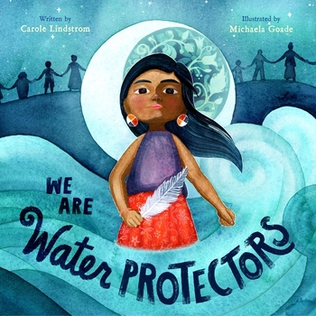
We Are Water Protectors is a 2020 picture book written by Carole Lindstrom and illustrated by Michaela Goade. Written in response to the Dakota Access Pipeline protests, the book tells the story of an Ojibwe girl who fights against an oil pipeline in an effort to protect the water supply of her people. It was published by Roaring Brook Press on March 17, 2020. The book was well received. Critics praised its message of environmental justice, its depiction of diversity, and the watercolor illustrations, for which Goade won the 2021 Caldecott Medal, becoming the first Indigenous recipient of the award. The book also received the 2021 Jane Addams Children's Book Award winner in the Books for Younger Children category.



















